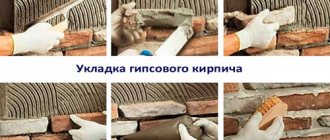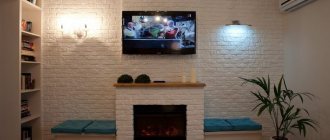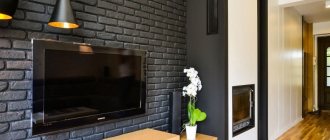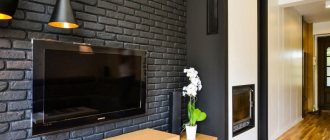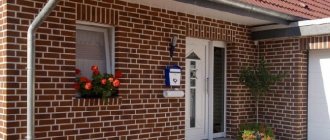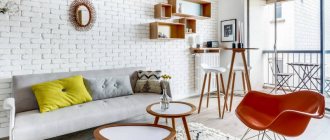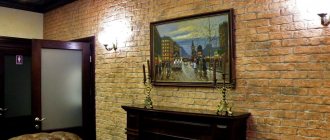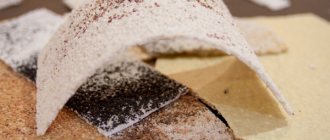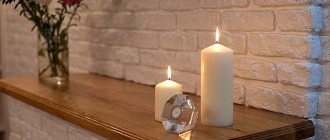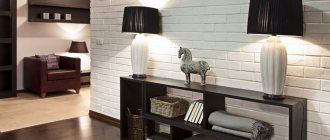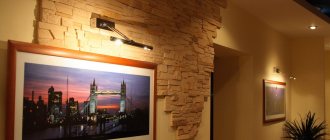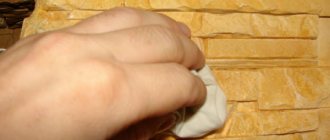Most homeowners, when deciding how to glue decorative bricks, prefer to entrust the finishing process to specialists. At the same time, having basic knowledge and skills in working with tiles allows you to create original interior accents with your own hands. Gypsum imitation brick is perhaps the most popular cladding option among those who want to emphasize a touch of originality in their own home using affordable material. The market also offers an impressive range of models made from various bases, including ceramic, polymer, cement and other types of false bricks.
Production of gypsum decorative bricks
Gypsum is the easiest raw material for making decorative bricks, literally and figuratively. Light in weight and easy to use, gypsum allows you to make finishing materials right at the workplace with your own hands. To do this, you only need desire, patience, the plaster itself, water, dyes and molds for casting.
Helpful information! To make it easier to remove the finished elements from the mold, it is necessary to lubricate it. Lubricant can be purchased at retail chains. Which one depends on the material of the molds.
You can also make your own molds. From the same plaster, concrete, wood or foam. This allows you to obtain parts of such a size and surface texture that sellers of ready-made decorative bricks cannot offer. All that remains is to use a mixer to knead the “dough” in a container, adding the desired dye to it, grease the mold, pour the solution into it and wait for it to harden. Even without experience, you can quickly master this simple technology using trial and error.
Filling form
Gypsum brick wall
Style icon
Decorative brick is valued for its variety of uses in the interior. The brutal but warm material is good both on its own and in combination with leather, wood, glass, and plaster. True, you shouldn’t completely decorate a room with it - the result looks very gloomy. But one accent wall, fireplace area, columns, niches or other elements in brick cladding look very colorful!
By the way, facing brick forgives some carelessness in installation. Therefore, you can glue it on yourself: masonry with minor defects looks more atmospheric.
It is not surprising that this material has organically entered into different interior styles. It adds a touch of freedom and serenity to loft and country. The gloomy restraint of Gothic and Neo-Gothic is unthinkable without the luxurious severity of brick: in combination with exquisite furniture, it creates the aura of a medieval castle. In the interiors of modern styles - pop art, hi-tech, art nouveau - the material in combination with wood, steel and glass is responsible for the atmosphere of sophistication and tranquility. White brickwork makes laconic minimalism and Scandinavian style simple and fresh. Except that in romantic styles that do not allow for rough structures, brick looks out of place: a symbol of reliability and durability does not fit well with the light, delicate filling of rooms.
Decorative brick made of cement
The main difference between cement and gypsum is mass and color. Cement is heavier than gypsum. Gypsum is usually white, and cement is gray, although it can also be colored. Otherwise, the manufacturing technology is the same as for gypsum.
Currently, there are other bulk materials and dry mixtures similar to gypsum and cement on the building materials market. They can also be used to make facing bricks.
Dry mixes
The only significant drawback of decorative bricks made of gypsum or cement is its fragility. Therefore, you need to be careful when working with it. On the other hand, this lack of strength makes it easy to cut into pieces for use where needed.
Of course, manufactured in an industrial environment, such material will be more durable and have a better appearance. There is one minus - in terms of colors and sizes, you will have to choose from what the market offers.
Types and characteristics of bricks
There are these types of finishes:
- On a cement or gypsum base with various dyes. Produced by molding.
- Clinker brick, which is expensive due to its production technology. The composition is exposed to high temperatures, which in turn improves its properties.
- Acrylic-based brick, the distinctive feature of which is lightness and strength, a varied palette of colors.
Decorative facing brick in the interior
- Ceramic brick. Main properties: not afraid of moisture and water, resistant to strong mechanical stress. When laying, it is worth using reinforced glue, since ceramic bricks are quite heavy.
- Porcelain stoneware brick. Its main advantage is exceptional strength, which is due to the presence of natural stone chips and binding material in the composition, as well as due to double annealing during manufacturing. The disadvantages include heavy weight and high price.
Application of clay and granite chips
Clay is the raw material for ceramics. By adding granite chips to clay, raw materials for porcelain stoneware are obtained.
Ceramic and porcelain stoneware products are produced on an industrial basis because the molded products are processed in kilns at high temperatures. This is difficult to do at home and on a construction site. Handicraft producers cannot guarantee the quality of their products.
Helpful information! When purchasing, you need to be very careful and it is best to contact companies that have all the relevant certificates.
Facing material made of ceramics or porcelain stoneware has high quality indicators. It is difficult to break and split. It is harder to saw and practically does not wear out. It can be washed and wiped without fear of damaging the surface texture and color.
Design
Brickwork may look so that, by looking at it, you can immediately understand what material the walls are decorated with. But the appearance of the products can be so diverse that the facade turns out to be truly unique. You can achieve an unusual effect using glazed, smooth or embossed brick. But engobed products have a smooth surface and a special production method. Using these products, you can clad the facade using bricks in unusual shades, for example, purple.
Smooth
If the aging effect is not suitable, you can choose smooth brick as the façade cladding. It can be based on different ingredients, and the color can also be selected from a wide variety of shades. But the appearance of the cladding allows you to decorate the walls in a classic style. Quite often, texture or its absence allows you to save money, because products from designer collections are usually more expensive. If the budget is limited, smooth brick is just right.
Embossed
Aged brick has a relief that makes the product look like cladding made centuries ago. Brick with relief can imitate natural materials, for example, wild stone.
Glazed
If you want to give the facade a shine, you should choose this cladding effect. It is usually combined with other trim or brick in a different color, size or shape. Glazed bricks usually have unusual shades. It is the wide range of colors that is their main advantage.
Engaged
Modern architects quite often began to use engaged brick for the reason that its appearance immediately catches the eye. The products can be successfully combined with other cladding options, giving the building sophistication and unique charm.
Other methods of finishing brick walls
The modern building materials market is rich in other finishing materials that allow you to decorate your interior in the style of brickwork. PVC is used to make flexible decorative brick-like tiles for interior decoration. Some manufacturers offer collections of decorative brick panels made of PVC and MDF. Tiles and panels differ in that they are not individual elements, but entire panels with an area of up to several square meters. They can be mounted directly on the wall or to a frame made of wooden blocks or metal profiles. They are much cheaper than decorative bricks and easier to work with.
Brick panels
There would be no happiness...
Brick has been used in construction for not even centuries, but millennia. But it began to be used as an independent finishing material less than a hundred years ago - a paradox! And it arose, essentially, by accident: in the 40s of the 20th century, due to a housing shortage in New York, the premises of former factories and factories began to be converted for living. At that time there was no time for style: powerful brick walls, pipes and wires on the ceiling - that’s the whole design.
However, the harsh Spartan interior suddenly turned out to be so colorful that it attracted the attention of designers and soon developed into a special style - loft. But simply knocking the plaster off the wall was not enough: ordinary building bricks did a poor job of finishing. There was a need for a new material - durable, beautiful, textured, small-sized. This is how decorative brick appeared.
How to choose decorative bricks for interior decoration
In order to choose the right decorative brick for the interior decoration of surfaces that will be decorated with it, you need to know some of the properties of the material from which it is made.
Gypsum
Gypsum is a material that is not moisture resistant. In order to somehow protect products made from it from moisture absorption, they must be coated with varnish or some other special protective agents. Low moisture resistance, along with fragility, determine the use of decorative gypsum bricks in places where there is no high humidity, and where the cladding is not subject to mechanical stress, where there is no need to wipe it frequently.
Decorative gypsum brick
Cement
Not afraid of moisture and slightly more durable than gypsum, cement facing material gives more freedom in its application. But it still should not be used for cladding external corners, which are often subject to impacts when carrying heavy objects.
Cement brick
Ceramics
Ceramic decorative brick has the following qualities:
- Capable of withstanding quite significant loads,
- Does not deform under large temperature changes,
- Not afraid of frost
- Porous, making it a good heat insulator
Ceramics
Porcelain tiles
Similar to ceramic, porcelain stoneware bricks differ:
- High mechanical strength,
- Frost resistance,
- Moisture resistance,
- Resistant to temperature changes,
- Protected from absorption of dust and dirt,
- Easy to clean.
Porcelain tiles
These qualities make it possible to use ceramic and porcelain stoneware decorative bricks on almost any surface indoors, as well as on loggias, terraces and verandas. This material has proven itself to be excellent when lining stoves, fireplaces and chimneys. If necessary, they can also be used to cover the outer walls of the house. And the strength of porcelain stoneware allows it to be used for indoor flooring.
Related article:
Standard brick: dimensions and characteristics. Which brick should you choose? What parameters does it have? About this and much more in a separate publication on our portal.
Possible façade finishing options
In addition to the classic finishing with decorative bricks, it is possible to install ready-made facade thermal panels. This is a special material that combines the properties of insulation and decorative cladding. It is a sheet of polystyrene foam or polyurethane foam with decorative tiles securely attached to its surface in several rows.
The tiles can be in the form of natural stone or brickwork. The panels have a fairly large area, which allows cladding to be carried out quickly and simply; the parts are connected using the tongue-and-groove principle.
Another finishing option is a ventilated facade. This is a cladding that is installed on special metal guides. Due to the gap between the wall and the metal, air can circulate and remove excess moisture.
Most often, hinged ventilated facades are used for cladding high-rise buildings.
Architectural and design solutions for interior design
Modern technologies and the widest range of raw materials, dyes and shapes make it possible to give decorative bricks for interior decoration a variety of sizes, colors and shades. This, in turn, allows you to design and implement a huge number of decoration elements, starting with individual parts of rooms and ending with interconnected interiors of individual rooms for the entire house.
The owners themselves can decide how certain rooms inside the house will look, how to decorate the fireplace or entrance areas. But it’s still better to consult with specialist designers. People with special education and experience in this matter will help you choose the facing material depending on the size of the rooms and the location of the lighting sources. They will take into account the general layout of the building, the level of humidity and areas with possible temperature changes and, most importantly, the color preferences of the inhabitants of the home for common areas and for each personal room, be it a bedroom or an office.
How to choose
The outer walls of a building need protection no less than the foundation of a house. If you decided to choose brick for cladding, then before purchasing it you should take into account several nuances. Firstly, you should look at the product - it should not have unevenness, cracks or chips. There should be no defects at all on the surface of the facing brick, since it is used to improve the appearance of the facade.
If whitish spots were noticed on the surface, this indicates the presence of lime in the composition. In the future, such a flaw may destroy the brick. This happens due to poor grinding and lime getting into the clay. It is this place that will subsequently become a source of moisture absorption.
Attention! If you decide to choose a ceramic brick, you should not only inspect it externally, but also knock on it. If a ringing sound is heard, the product can be purchased. Whereas if there is a dull sound, it can be argued that the buyer is looking at an unburned product.
You should not place all the responsibility for protecting the walls of your house on the brick. It is usually laid, supplemented with heat and vapor barrier. And if there is also no wind insulation, this can reduce the life of the building. When the material for all internal layers has been purchased, you can proceed to purchasing the cladding. For the facade, it must belong to the same party, otherwise you may encounter a discrepancy.
Execution of work
Should I buy ready-made decorative bricks for interior decoration or make them myself, cover the walls with them myself, or contact companies specializing in providing such services? The decision about this should be made depending on the presence or absence of your own skills and abilities and financial capabilities. The time factor is of no small importance. In any case, you need to understand that specialists will complete the work faster and with better quality.
If you decide to do everything yourself, then when selecting raw materials, it makes sense to listen to the advice and recommendations of sales consultants. Having all the information about the products offered, they will help you better select components for making bricks, adhesives, mastics, molds, dyes and tools so that the work does not cause unnecessary surprises and disappointments. You can also consult with them regarding technologies for preparing forms, mixing mixtures, terms and conditions for drying bricks and sticking them on surfaces intended for cladding.
Helpful information! If the retail outlet cannot answer the questions asked, then it makes sense to go to another store where they will give full advice.
In the case when it is decided to entrust the work to specialists, the customer is responsible for the issues of project approval, financing and control over the quality and timing of the work.
The price of decorative bricks for interior decoration depends on many factors. This is both the raw material and its quality. These are production technologies and the “brand” of the manufacturer. Trade margins and discounts for quantity purchased also play a role.
For comparison, you can see the prices for individual collections from some manufacturers.
Table 1. Average cost of decorative bricks
| Image | Manufacturers | Name of collections | Price RUR per 1 m² |
| Group | Slimbrick | from 997.1 | |
| AnticBrick | from 1121 | ||
| KAMROK-PRO LLC | Antique brick | from 700 | |
| Hanseatic brick | from 700 | ||
| Clinker brick | from 700 | ||
| Romanesque brick | from 800 | ||
| Old brick | from 700 | ||
| Bergen | from 940 | ||
| Bruges | from 940 | ||
| Bremen | from 890 | ||
| Paris | from 890 | ||
| Louvre | from 940 |
In one article it is impossible to cover the entire palette of prices and collections for this facing material. Moreover, each collection includes several sets, differing in shades of colors from the lightest to almost black.
Helpful information! When coordinating design solutions for each room and interior element, it is necessary to take into account the availability in the nearest shopping centers of affordable and quality material offered by designers or the possibility of supplying it to order. Then the work will be completed on time and its cost will not greatly exceed the estimate.
Advantages and rules of choice
Hyperpressed facing bricks are in great demand due to their technical characteristics. This is an almost universal building material. The main raw materials for its production are clay, limestone, dolomite, blast furnace slag, and waste of various rocks. Cement and coloring pigments are added in small quantities. According to the differences in design, there are hollow and solid facing bricks, and according to the shape - regular and figured or shaped. This type of material is used for finishing both facades and interior work.
Advantages of decorative facing bricks
Its main advantages are the following properties:
- high strength;
- resistance to environmental factors such as frost, snow, wind;
- long service life (up to 200 years);
- high masonry strength;
- fire resistance;
- low moisture absorption;
- ability to work in any season and at any air temperature;
- variety of shades and textures.
Vancouver facing brick can be used for both interior and façade wall decoration. This cladding option will help create an imitation of classic brickwork with some twist. The peculiarity is the absence of pores in the structure of the brick, which makes it look like natural stone. And this speaks of its strength and wear resistance.
Also, the positive properties of this material include excellent sound and heat insulation. Another advantage is its small thickness, which will avoid additional load on the foundation when used indoors. No preliminary surface preparation such as primer or plaster is required. With Cambridge decorative facing bricks, which are suitable for both interior and exterior use, you can achieve the effect of old brickwork through the use of several shades. This cladding option will make the interior of your home unusual and attractive.
Decorative brick on the facade of the house
A distinctive property of this material is its exceptional frost resistance, which makes it popular among consumers. Also, due to the high density, moisture absorption is quite low, which makes it possible to use Cambridge facing bricks outside. In addition, the light weight will make it possible not to load the wall and stay on the surface firmly and for a long time.
Using Avignon decorative facing bricks for wall decoration will make the interior of your apartment or house chic and sophisticated. The material of this brand is presented in 9 different shades. Externally, it is close to natural stone, with its inherent irregularities and roughness. It is often used as a decorative element when decorating interiors in loft, minimalism, and neo-Gothic styles. It is highly durable and easy to use.
The use of decorative facing bricks Naples will help decorate your home both inside and outside. The collection from Leonardo Stone presents a huge selection of this material, with which you can decorate your home in a discreet, sophisticated style.
Using “Besser” chocolate 250*120*88 for finishing decorative facing bricks will allow you to get an excellent result. With its help, it is possible to both decorate internal walls and build various structures: interior partitions, load-bearing columns, gazebos, fences, etc. It has exceptional strength and frost resistance.
Laying decorative bricks (video)
Rules for selecting stone for finishing
Decorative stone has many advantages, including:
- Fire resistance;
- Safety from the point of view of household health;
- Wear resistance;
- Easy to maintain and clean;
- Large selection of shapes, palettes and textures.
In order to correctly combine all the positive properties and the external side of the material, you should clearly think in advance what exactly will be decorated with this material. And here it is important to consider the following factors:
- Price characteristics. Based on the available budget, the countdown of the main points begins;
- Weight. For certain walls and arches only light forms are required;
- Appearance. For every person, one or another texture, shape, color scheme is important;
- Strength. The kitchen space also requires moisture resistance; no one will change the lining every week.
Installation of hard bricks
As mentioned earlier, the finishing work is almost the same as with flexible tiles. But to cut the material you will need a jigsaw or a circular saw.
The difference in finishing lies in the specific placement of the material. A layer of adhesive for hard tiles is needed a little thicker than in the previous case. It will be approximately 3 - 4 mm. Usually, the packaging with brick tiles contains instructions for its installation, and you should follow them.
During the process, you should check how evenly each layer is laid using a building level. To create perfectly even distances between tiles, you can use special calibrators - an analogue of cross-shaped inserts when installing ceramic tiles. After finishing work they are removed.
The main difference is the need to seal the seams after the adhesive has dried. This is done with special grouts using ready-made guns of various types or a homemade syringe from a plastic bag. The grout must have plasticity in order to completely fill the seams.
Features of the use of artificial stone
Thanks to the variety of patterns and colors, decorative stone is a real “must have” for a modern interior.
Minimalism, if you use stone, becomes less bland, a Scandinavian interior becomes more diverse, eco-style and country style become more convincing, and a loft becomes much more comfortable.
Many ethnic styles are difficult to imagine without facing stone. For example, in a Mediterranean house this is a stylization of pebbles or boulders polished by the sea. In Alpine - under mountain debris. The interior is Provence-like, like sun-bleached sandstone. In English - under a strict cherry-colored brick. Artificial, glossy stone has made its way even into high-tech interiors, this “fiefdom” of metal and glass.
Stone is, of course, a unique tool for creating an extraordinary environment, but you shouldn’t go to all lengths. If you decorate the walls with stone tiles from top to bottom, you will get a crypt, a wine cellar, a dungeon... But not a living space.
Cladding with decorative stone solves several problems. Firstly, it is picturesque, elegant and prestigious. Secondly, with the help of stone you can delimit a room into functional zones, make it more voluminous and expressive.
Repair of brickwork of external walls
If the brickwork partially fails, it may be considered unsafe. Otherwise, repairs can be made. To do this, the site is cleared and individual bricks are removed. External seams should be cleaned and frayed edges removed. The most convenient way to do this is to use a hammer drill and a grinder. To increase adhesion, priming should be done. New bricks are installed in place of the removed bricks. Their laying is carried out using mortar. The bricks are pre-soaked.
Engagement
Gypsum brick is considered a convenient material for finishing surfaces, but is significantly inferior in strength to ordinary bricks. In order for a brick wall to serve you for a long time, it is necessary to maintain the necessary conditions; in rooms with high humidity, it is not recommended to decorate the wall with gypsum bricks.
- A common design solution was laying gypsum bricks on the walls in the hallway.
- The decor of gypsum bricks on windows, doorways, and staircases looks original and unusual.
- You can use gypsum bricks in private and country houses.
If you live in a cottage, the stairs can be decorated with brick.
Stone cladding options
There are several facing options.
Corridor and hallway
Due to its wear resistance, practicality, easy care and presentable appearance, decorative stone is especially often found in the corridor or hallway.
Decorative stone in the living room interior
The stone is associated with reliability and safety. If it is present in the living room, the household members feel more confident, “like behind a stone wall.”
The stone is also associated with fire, with the warmth of the hearth. Man has carried the memory of the tandem of fire and stone from cave times; it is not for nothing that fireplaces are still covered with rubble and cuts today. However, not only fireplace portals are decorated with granite, brick or shell rock tiles.
Decorative stone is used to line niches with lighting, shelves, glass display cases, a fragment of a wall with a TV panel or behind a sofa.
Decorative stone, due to its structure, absorbs a lot of light. Therefore, designers advise alternating it with light plaster or wallpaper. Remember also that finishing with artificial stone will require additional lamps and a well-thought-out lighting scenario.
Decorative stone is especially good in a studio apartment. Perhaps this is the simplest, most budget-friendly, most relevant way to divide your home into locations.
Decorative stone in the bedroom
Here the stone will become a talisman: it will calm, lull, and bring back memories of something dear, truly natural.
A massive, high-quality bed is ideally combined with walls covered with decorative bricks, as well as with wooden beams, caissons, and sconces in the form of candelabra.
In the bedroom it is better not to use stone tiles with a glossy surface to avoid a “cold”, disturbing flicker. And don’t forget to highlight the fragment lined with stone with lamps, which will make the texture softer and warmer.
Usually the stone is used to decorate the wall behind the head of the bed or the corner with the dressing table and mirror. Unlike the hallway, where transitions from stone to plaster are made using torn edges and flows, other, less noticeable techniques are used in the bedroom. For example, they mark masonry with moldings.
Decorative stone in a children's room
The environmental friendliness and safety of artificial stone tiles ensured its entry here.
It is also important that with the help of a stone you can embody the plot of your favorite fairy tale. Let’s say, create a “princess castle”, “Ali Baba’s cave”, “dungeon of the gnomes”, “underwater grotto”.
With artificial pebbles it is easy to lay out a mosaic, a panel, paint the pebbles to look like snails and ladybugs, decorate a landscape on the wall with a frame of stones, or a niche with toys.
If we are talking about a teenager’s room, then artificial brickwork near the desk will discipline him and call him to order. And resonate with more adult toys - car models, a globe, things in the steampunk style.
Kitchen
The volume, naturalness and texture of this cladding will undoubtedly attract attention and give the kitchen or dining room a certain image.
Decorative stone in the bathroom
A natural pool carved into the rocks - this is what a bathroom decorated with stone tiles might look like.
In the bathroom, glazed stone that does not absorb moisture and porcelain tiles are used. As well as cast marble and onyx - composite materials made from stone chips, coloring pigments and polyester resins. The latter type of finishing is becoming increasingly popular because it looks like noble and valuable rocks - jasper, malachite, lapis lazuli, translucent onyx.
A part of the wall with an attached mirror, a recess in which candles are lit, a countertop above the sink, lined with glossy, purebred tiles, will transform and elevate the interior of a standard bathroom.
Balcony and loggia
Decorative stone will allow you to turn a balcony or loggia into a cozy relaxation place and create a more thoughtful design.
Tips for working with the material
- Laying should begin from the corners, guided by the beacons and periodically checking the horizontal level.
- In order for the masonry joint to be uniform, you should use a calibrated metal rod with a square section. This method is one of the simplest and most accessible today.
- The connection with the main wall can be realized with a masonry mesh. In this case, no reinforcement is performed.
Attention! If the masonry is supplemented with colored mortar, this will make the facade more original and attractive.
Installation of flexible bricks
You don’t need complex tools for this DIY finishing. You will only need spatulas - a smooth one designed for mixing the glue and a serrated one for applying it, a level, a ruler, a marking cord, a marker and construction scissors, a brush for leveling the mortar in the seams.
In addition to tools, you will need materials. These are: the tile itself, tile adhesive and primer for preparing the walls.
Before installation begins, the wall is prepared in any case. To do this, its surface is cleaned, leveled and coated with an antiseptic primer. After the surface has dried, you can begin laying decorative bricks.
Important! Work on the interior decoration of walls with decorative bricks can only be carried out at a temperature not lower than +5 degrees, so that the adhesion of the material does not decrease.
Installation of the coating is carried out according to the following algorithm:
- Marking the wall into equal-sized zones where the tiles will be glued.
- Applying the adhesive composition to certain areas with a layer of approximately 2 - 3 mm with an even spatula, and then processing with a serrated one to obtain peculiar grooves.
- Gluing tiles in rows in the form of natural masonry. Seams of approximately 1 cm are left between the rows, depending on the desired effect.
- Leveling the glue in the seams using a brush.
- Such decorative bricks do not require grouting, which helps to significantly save time and budget.
Advice! Before starting installation, it is better to remove all the elements from the packages and mix them together to achieve a natural distribution of the shade.
What textures are used in cladding?
Artificial or decorative stone in the interior of an apartment is:
- fashionable;
- exquisite;
- aristocratic;
- extravagantly;
- luxuriously;
- creative.
The most luxurious look is white stone in the interior or covered with enamel. It does not destroy the special atmosphere of the bedroom and perfectly sets off other finishing materials and textiles. It fits perfectly into most styles, regardless of texture. The best solution for a modern bedroom is with imitation white marble on top of a “warm floor” system. The wall cladding behind the head of the bed can be of any texture and not necessarily white.
For design purposes, sometimes a rough texture or contrasting finish is needed. This is used in urban and technological styles - loft, hi-tech or techno. Upholstered furniture of unusual shape requires a corresponding wall or panel. A spectacular backdrop behind a sofa or armchairs, lined with stone decor in a living room or large recreation area, looks very stylish.
Typically, decorative stone is used in hallways and corridors
The fireplace looks elegant against the background of a stone wall
Some people like it when decorating a living space with stone brings a special “wild” atmosphere. The room is more reminiscent of a deserted beach near a cliff, a stone grotto in the mountains, or a cave inhabited by modern city dwellers. In this case, a material with a texture close to the natural surface is used.
Photo wallpaper with a 3D effect, roughly processed wood and vertical landscaping - a wall with living plants - will give a special impression to the “wild nature” corner. Artificial stone in such an interior should imitate natural analogues as much as possible, the masonry should be uneven and a little chaotic. This is exactly what an eco-style room should look like - photo.
Decorating an apartment often involves the use of smooth polished pebbles (river or sea) or colored sea pebbles. An excellent way to use it is to lay out a mosaic pattern, and then paint some fragments. An excellent solution is to lay out pebbles on a kitchen splashback or a decorative panel in a living room.
Finishing the walls with decorative stone would be the right decision.
The wall decoration in the living room is made of decorative gray stone
Decorative stone in the living room will look chic
The use of rough textures has no restrictions for people with imagination and a creative approach to business. But sometimes this goes beyond reason, and luxurious decoration can look gloomy and uninviting for various reasons:
- too small room, narrow walls;
- the proportional limit of the stone texture of the floor and walls has been exceeded;
- different types of cladding are poorly arranged;
- The cladding does not match the style.
Designers prefer this type of room decoration for the special atmosphere of stone. Other materials do not have such a magical aura. But it should not be used as the main material, only as a spectacular decor.
Decorative stone is very durable and perfectly complements the design of the room
The right decision would be to decorate the walls in the kitchen with decorative stone
Spectacular examples in the exterior
Some modern consumers refuse to decorate their houses with bricks for the reason that this cladding seems very ordinary to them. But, looking at the spectacular examples, you can understand that the facade can turn out to be so original that a better material for the walls simply cannot be found.
- So, if the house has an interesting architectural design, for example, columns, they can be faced with bricks of the same color, and the rest of the external walls can be decorated with textured products of a contrasting shade.
- When a house has a simple shape, it can also be decorated in a very unusual way. You can use bricks for masonry, combining their texture and shades. Contrasting colors look good. Dark bricks can be laid in the lower part, continuing the tab on top with products in light colors.
- Even if brick was chosen as the cladding, there is no need to decorate the entire facade with it. You can complement the decorative finishing with stucco, which will turn an ordinary house into a real palace.
- Classic brick is often combined with imitation natural stone. And if the windows and doorways have an unusual shape, such a combo will not only highlight the appearance of the house from all other options, but will also make the building the envy of the neighbors.
